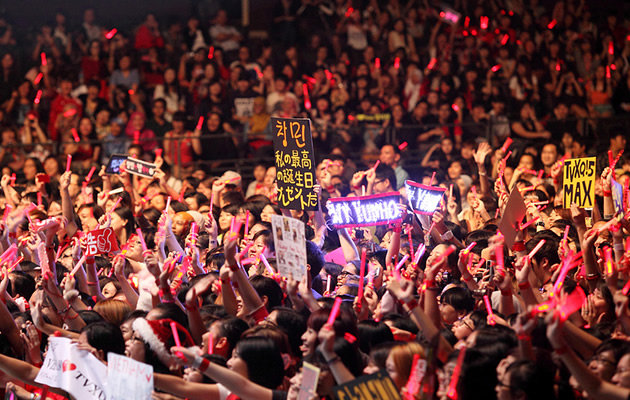 If you’ve been keeping up with my “Quick Guide” series, you probably have a K-pop bias and may have some K-pop friends to share your hobby with by now. These guides are meant to help you integrate yourself into K-pop community and once you’ve become more deeply entrenched in the K-pop scene you will inevitably discover the existence of fandoms. Sure, some people are just here for the music, so maybe you won’t ever want to bother with the internal politics of fan relations in the K-pop world, but more likely than not it will be unavoidable.
If you’ve been keeping up with my “Quick Guide” series, you probably have a K-pop bias and may have some K-pop friends to share your hobby with by now. These guides are meant to help you integrate yourself into K-pop community and once you’ve become more deeply entrenched in the K-pop scene you will inevitably discover the existence of fandoms. Sure, some people are just here for the music, so maybe you won’t ever want to bother with the internal politics of fan relations in the K-pop world, but more likely than not it will be unavoidable.
You may be familiar with the word “fandom” as a term from experiences outside of K-pop. Fandoms exist for everything from movies, to TV shows, to books, to singers, and are comprised of a large group of fans forming a community dedicated to every aspect of that special thing. Harry Potter, Doctor Who, and One Direction are all examples of things that have large international fandoms.
 In K-pop, it is more complicated because there is not only a fandom for “K-pop” as a whole, but also a fandom for each individual K-pop group and even sub-fandoms for individual group members. For example, you could be a fan of K-pop, and your favorite group could be SHINee, making you a part of the SHAWOL fandom, and your bias in SHINee could be Taemin, making you a Taemint.
In K-pop, it is more complicated because there is not only a fandom for “K-pop” as a whole, but also a fandom for each individual K-pop group and even sub-fandoms for individual group members. For example, you could be a fan of K-pop, and your favorite group could be SHINee, making you a part of the SHAWOL fandom, and your bias in SHINee could be Taemin, making you a Taemint.
Being involved in fandoms in K-pop is tricky because of this intricate division system. It is easier when you are part of a fandom that doesn’t have so many different individual components because those don’t allow for as much infighting. If fans of Harry Potter and Twilight had a disagreement over which movie had a better director you couldn’t generalize it away by saying, “come on guys, they are both movies!” because the category of “movie” is too broad.
With K-pop it is more justified for people try to minimize arguments by saying that individual group fandoms should get along because “it is all K-pop.” However, that doesn’t stop people from feeling more committed to one group than another. K-pop is a less general term than “movies” because it is still a niche market, but it is a huge niche and likewise it is easy to forget that all of these groups really are part of one overarching fandom. There are tons of different types of groups with different concepts from different companies with different levels of popularity and likewise K-pop is a fandom simply begging for internal conflict.
 Once you’ve become accustomed to the fact that K-pop is a fandom – and a big one at that — you will want to consider whether you want to be a part of specific group fandoms as well. There are many different levels of involvement when it comes to being in a group fandom. If you happen to be in South Korea, speak Korean, or are particularly devoted, you can take the “official” route and become a part of a K-pop group’s official fan café website. If you are in South Korea this will link you to a community of other fans as well as give you access to things like exclusive merchandise and entrance at music shows – and even direct communication with the group at times.
Once you’ve become accustomed to the fact that K-pop is a fandom – and a big one at that — you will want to consider whether you want to be a part of specific group fandoms as well. There are many different levels of involvement when it comes to being in a group fandom. If you happen to be in South Korea, speak Korean, or are particularly devoted, you can take the “official” route and become a part of a K-pop group’s official fan café website. If you are in South Korea this will link you to a community of other fans as well as give you access to things like exclusive merchandise and entrance at music shows – and even direct communication with the group at times.
However, for the international fans this is often not an option. Although there are guides on how to join official fan cafes online that will walk you through the Korean, there aren’t as many benefits if you aren’t anywhere near South Korea. Being a part of these official fandoms can also be a big commitment and can mean you are expected to give up being a fan of any other groups. This isn’t as common among international fans, who tend to be fans of many groups, so commitment to an official fan café, even if you are currently living in Korea, may not be the way you want to go.
 You can also participant in international fan groups for a slightly less formal and more accessible fandom experience. There are plenty of international fan sites for K-pop groups, they just aren’t formally associated with the group’s company. These websites are often good places to find all of the news about your favorite group and to meet other fans. International fan groups will often attend concerts and conventions related to K-pop to get their names out there and to promote the group they are devoted to.
You can also participant in international fan groups for a slightly less formal and more accessible fandom experience. There are plenty of international fan sites for K-pop groups, they just aren’t formally associated with the group’s company. These websites are often good places to find all of the news about your favorite group and to meet other fans. International fan groups will often attend concerts and conventions related to K-pop to get their names out there and to promote the group they are devoted to.
Some examples of benefits of participating in an international fan site include scheduled group hang-outs online (because fangirling is much better with friends), detailed information about the groups promotions and appearances, and opportunities to support your favorite group through things like rice wreaths and charities. Participation in these kind of groups and activities are the closest you can get to being part of an official fan café without actually joining one.
 If organized fandom isn’t for you, well, there are a million ways to be a fan on your own. Some people contribute to the fandom by editing photos, writing fan fiction, or translating shows and music videos for those in the community that don’t speak Korean. Tumblr – as crazy as it can be – is a hub for K-pop fans wanting to share their love for the genre with others and likewise is a good place to get involved in the K-pop fandom. You don’t even have to “contribute” anything to be a fan, simply partaking in photos and videos posted by other fans is a fine way to be a part of the community.
If organized fandom isn’t for you, well, there are a million ways to be a fan on your own. Some people contribute to the fandom by editing photos, writing fan fiction, or translating shows and music videos for those in the community that don’t speak Korean. Tumblr – as crazy as it can be – is a hub for K-pop fans wanting to share their love for the genre with others and likewise is a good place to get involved in the K-pop fandom. You don’t even have to “contribute” anything to be a fan, simply partaking in photos and videos posted by other fans is a fine way to be a part of the community.
Hopefully this brief overview of fandom involvement has helped you orientate yourself in the world of K-pop. There are a million more little intricacies and details about K-pop and fandom life that simply can’t be covered here. There are fandom names, fandom colors, fan chants, and fandom politics that span the years that are too deep to explain without writing a book. In the end, no one can tell you how to be a fan, you have to do what works for you. Don’t let anyone tell you that you are “not a real fan” for any reason, because what really makes you a fan is how you feel in your heart.



